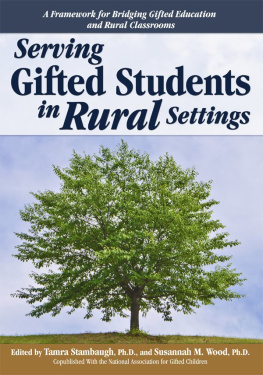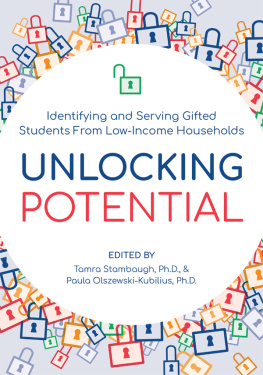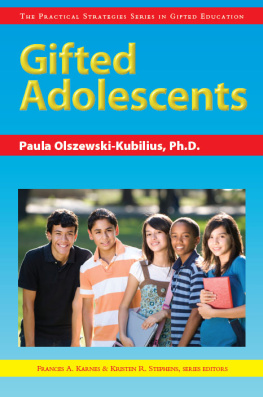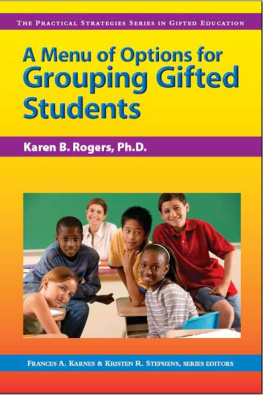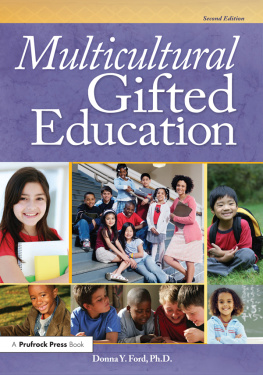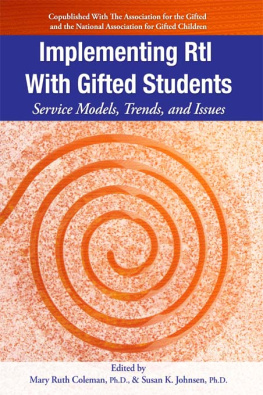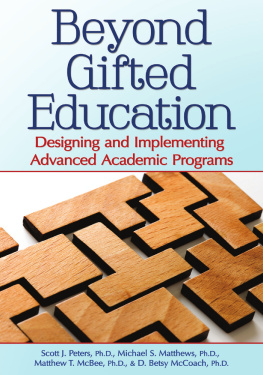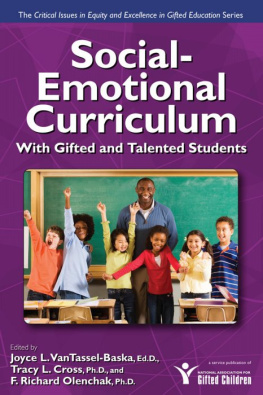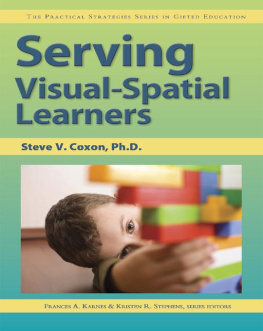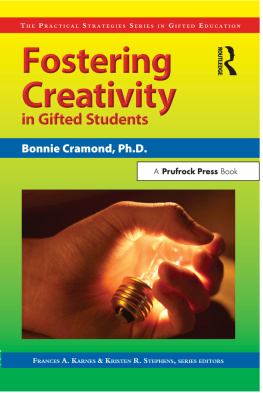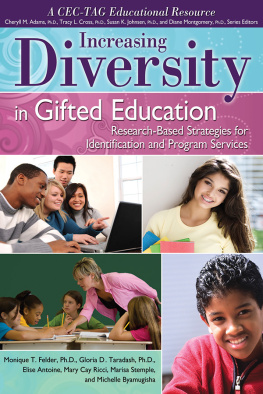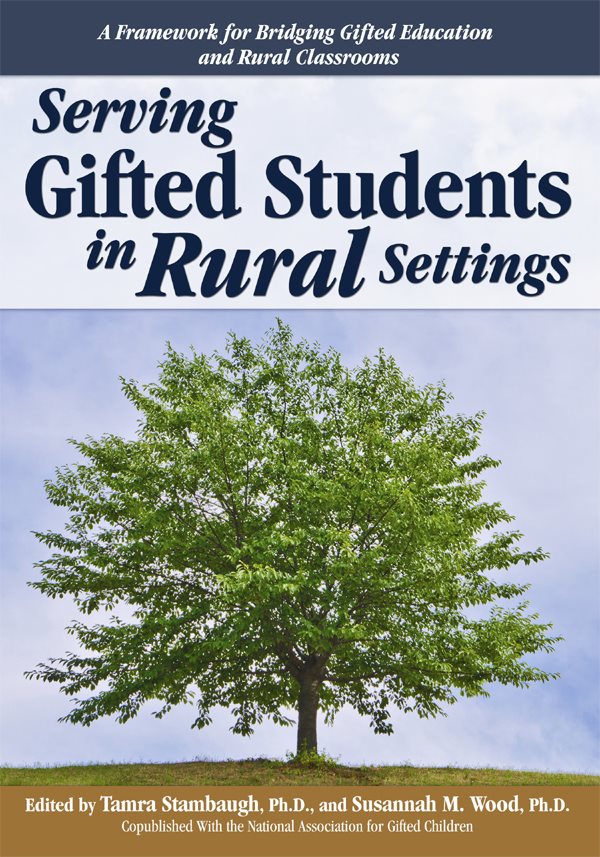
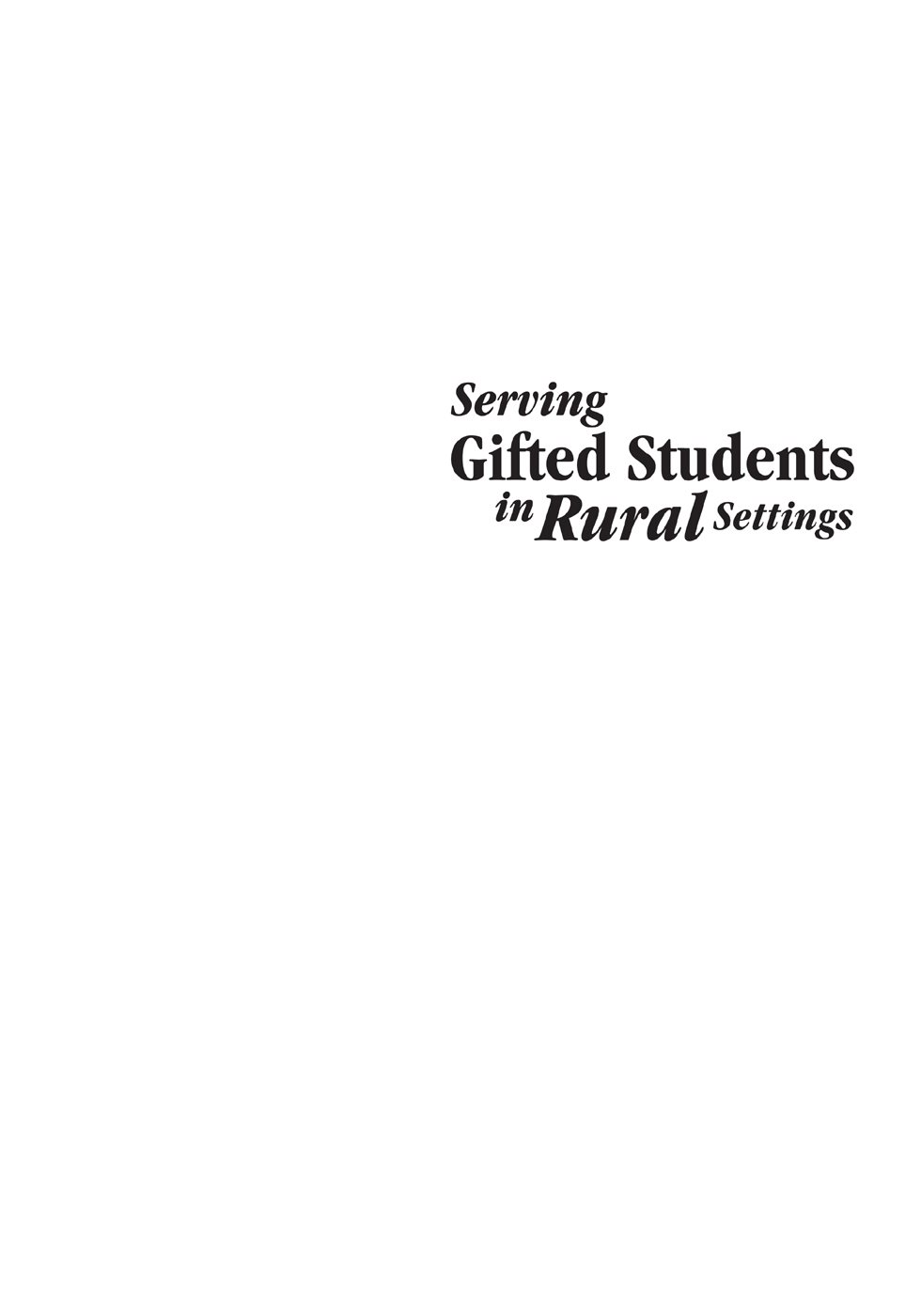

Copyright 2015, Prufrock Press Inc.
Edited by Rachel Taliaferro
Cover design by Raquel Trevino and layout design by Allegra Denbo
ISBN-13: 978-1-61821-431-7
No part of this book may be reproduced, translated, stored in a retrieval system, or transmitted, in any form or by any means, electronic, mechanical, photocopying, microfilming, recording, or otherwise, without written permission from the publisher.
At the time of this books publication, all facts and figures cited are the most current available. All telephone numbers, addresses, and websites URLs are accurate and active. All publications, organizations, websites, and other resources exist as described in the book, and all have been verified. The authors and Prufrock Press Inc. make no warranty or guarantee concerning the information and materials given out by organizations or content found at websites, and we are not responsible for any changes that occur after this books publication. If you find an error, please contact Prufrock Press Inc.

| Prufrock Press Inc.
P.O. Box 8813
Waco, TX 76714-8813
Phone: (800) 998-2208
Fax: (800) 240-0333
http://www.prufrock.com |
TABLE OF CONTENTS
Foreword
How to identify the academic and social needs of gifted students has been a major challenge in education for the past 50 years. Unlike other areas of special focus, gifted education carries the added burden of fighting political and philosophical battles regarding elitism and relevance in times of resource shortages in education.
I have been involved in gifted education for more than 40 years and I have seen a number of trends in the field. There have been times when gifted education oscillated between being in regarding a national agenda and when it was out. Over the decades gifted education has survived and changed based on research and practice. The challenges remain, as they do in all aspects of education, yet gifted education is vibrant and clearly focuses on an important and fascinating group of students, those we identify as gifted and talented.
One area within gifted education that has not received due attention has been gifted students in rural settings. Although there is understandably considerable attention to education issues in urban settings, there are still a large number of Americas students who attend rural schools. These students reflect the fabric of our society.
When we speak of gifted students we invariably are speaking of a minority in terms of numbers and in terms of special needs. The needs for differentiated curricula, acceleration, and grouping for peer group experiences become more challenging in rural settings not only because of smaller numbers in schools but also because of distance from resources such as museums, libraries, and centers that can enrich the K12 experience. Although technology has minimized some of these issues, we still have much to understand and respond to in terms of providing a fair and appropriate educational experience to gifted students in rural areas.
This book focusing on rural issues has been needed and I am confident will make its contribution to the field. It is comprehensive in that it covers an array of important topics from philosophies, to identification, to acceleration, to technology, to diversity, to poverty, to counseling, to advocacy. The chapters are written by a number of highly respected scholars and practitioners in the field.
I am familiar with the work of Drs. Stambaugh and Wood. They are intelligent, productive, and dedicated scholars in gifted education. They will continue to be strong, forward thinkers in the field, and I believe this book will be a benchmark contribution in their careers.
Serving Gifted Students in Rural Settings is a bridge to past work in gifted education as well as future issues and trends. We have been provided a valuable resource.
Nicholas Colangelo, Ph.D., Dean,
College of Education, University of Iowa
Myron and Jacqueline Blank Professor of Gifted Education
PART I
The Rural Life
CHAPTER 1
National Context of Rural Schools
Zachary J. Richards and Tamra Stambaugh, Ph.D.
What Is Rural?
When presented with the term rural, one is likely to conjure clichd images of idyllic landscapes, from rolling green hills and abundant pastures to winding roads and fenced in farmland. There is much more to the concept of ruralness than these rustic images provide. For one, Duncan (2012) discussed the implications for these communities when we move beyond such idealized fantasies. Not all rural spaces are the same, nor are these spaces created equal. Where some areas like the Upper Peninsula of Michigan or the Rocky Mountain West benefit from the touristic and retirement allure that their natural beauty and resources generate, regions like the South, Midwest, and Appalachia do not find themselves in such a fortunate situation. In these circumstances, markets are not as strong and there do not exist such beneficial factors enticing others to spend their time and money in these communities (Duncan, 2012).
Also important to understanding the essence of rural communities is how their far-flung physical locations from urban centers situate them in a position where accessibility to many modern conveniences is hard-found. Difficulties in obtaining broadband connectivity, developing basic frameworks for services like water and sewage access, and meeting transportation needs complicate the rural landscape (Battelle for Kids, 2014). Instead of public transit services, everyone relies on cars and trucks for getting around. These remote communities lack the infrastructural necessities to support economic growth, and because of this shortcoming in commercial viability, the institutions that make up rural areas are much less diverse than their urban counterparts (Duncan, 2010).
Nailing down what rural means is no simple task. Should a community be labeled as rural based on its geographic location, or by the number of people living there? Do agricultural economies or the way land is used determine that a community is a rural one? When do urban areas end and rural ones begin? Federal agencies use more than two dozen definitions to characterize a community as rural depending on the issues at hand, emphasizing the multifaceted considerations needed to capture this complicated idea. Generally speaking, rural communities are defined as not urban. In addition to using purely jurisdictional boundaries to delineate the rural from the urban, examinations of settlement density and cities influence on labor, trade, and media also matter for drawing this line. Residents in rural areas are not as concentrated as those of their urban counterparts, and they do not find themselves within a reasonable commuting distance to urban cores for employment and other necessities. Population size also matters, although ascertaining an appropriate threshold for characterizing a community as rural is subject to ongoing debate. With technological developments in the 20th century organizing economic and social activities around cities and large towns, recalibrations were necessary to take suburban development into account. Where a rural population was once defined as those communities with less than 2,500 people in 1910, this definition is now more fluid. A rural characterization is applied to areas with populations between 2,500 and 50,000 people, depending on the situation (Cromartie & Bucholtz, 2008).
Next page
